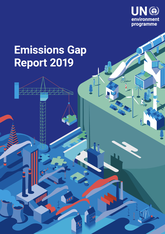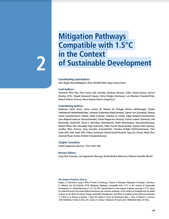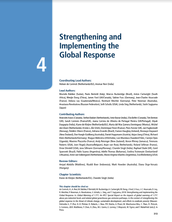Integrated Assessment Model Resources
Emissions Gap Report 2019

This is the tenth edition of the United Nations Environment Programme (UNEP) Emissions Gap Report. It provides the latest assessment of scientific studies on current and estimated future greenhouse gas (GHG) emissions and compares these with the emission levels permissible for the world to progress on a least-cost pathway to achieve the goals of the Paris Agreement. This difference between “where we are likely to be and where we need to be” has become known as the ‘emissions gap’.
This Emissions Gap Report has been prepared by an international team of leading scientists, assessing all available information, including that published in the context of the IPCC special reports, as well as in other recent scientific studies. The assessment production process has been transparent and participatory. The assessment methodology and preliminary findings were made available to the governments of the countries specifically mentioned in the report to provide them with the opportunity to comment on the findings.
This Emissions Gap Report has been prepared by an international team of leading scientists, assessing all available information, including that published in the context of the IPCC special reports, as well as in other recent scientific studies. The assessment production process has been transparent and participatory. The assessment methodology and preliminary findings were made available to the governments of the countries specifically mentioned in the report to provide them with the opportunity to comment on the findings.
Mitigation Pathways Compatible with 1.5°C in the Context of Sustainable Development

This chapter assesses mitigation pathways consistent with limiting warming to 1.5°C above pre-industrial levels. In doing so, it explores the following key questions: What role do CO2 and non-CO2 emissions play? {2.2, 2.3, 2.4, 2.6} To what extent do 1.5°C pathways involve overshooting and returning below 1.5°C during the 21st century? {2.2, 2.3} What are the implications for transitions in energy, land use and sustainable development? {2.3, 2.4, 2.5} How do policy frameworks affect the ability to limit warming to 1.5°C? {2.3, 2.5} What are the associated knowledge gaps? {2.6}
The assessed pathways describe integrated, quantitative evolutions of all emissions over the 21st century associated with global energy and land use and the world economy. The assessment is contingent upon available integrated assessment literature and model assumptions, and is complemented by other studies with different scope, for example, those focusing on individual sectors. In recent years, integrated mitigation studies have improved the characterizations of mitigation pathways. However, limitations remain, as climate damages, avoided impacts, or societal co-benefits of the modelled transformations remain largely unaccounted for, while concurrent rapid technological changes, behavioural aspects, and uncertainties about input data present continuous challenges. (high confidence) {2.1.3, 2.3, 2.5.1, 2.6, Technical Annex 2}
The assessed pathways describe integrated, quantitative evolutions of all emissions over the 21st century associated with global energy and land use and the world economy. The assessment is contingent upon available integrated assessment literature and model assumptions, and is complemented by other studies with different scope, for example, those focusing on individual sectors. In recent years, integrated mitigation studies have improved the characterizations of mitigation pathways. However, limitations remain, as climate damages, avoided impacts, or societal co-benefits of the modelled transformations remain largely unaccounted for, while concurrent rapid technological changes, behavioural aspects, and uncertainties about input data present continuous challenges. (high confidence) {2.1.3, 2.3, 2.5.1, 2.6, Technical Annex 2}
Strengthening and Implementing the Global Response

Limiting warming to 1.5°C above pre-industrial levels would require transformative systemic change, integrated with sustainable development. Such change would require the upscaling and acceleration of the implementation of farreaching, multilevel and cross-sectoral climate mitigation and addressing barriers. Such systemic change would need to be linked to complementary adaptation actions, including transformational adaptation, especially for pathways that temporarily overshoot 1.5°C (medium evidence, high agreement) {Chapter 2, Chapter 3, 4.2.1, 4.4.5, 4.5}. Current national pledges on mitigation and adaptation are not enough to stay below the Paris Agreement temperature limits and achieve its adaptation goals. While transitions in energy efficiency, carbon intensity of fuels, electrification and land-use change are underway in various countries, limiting warming to 1.5°C will require a greater scale and pace of change to transform energy, land, urban and industrial systems globally. {4.3, 4.4, Cross-Chapter Box 9 in this Chapter}
Although multiple communities around the world are demonstrating the possibility of implementation consistent with 1.5°C pathways {Boxes 4.1-4.10}, very few countries, regions, cities, communities or businesses can currently make such a claim (high confidence). To strengthen the global response, almost all countries would need to significantly raise their level of ambition. Implementation of this raised ambition would require enhanced institutional capabilities in all countries, including building the capability to utilize indigenous and local knowledge (medium evidence, high agreement). In developing countries and for poor and vulnerable people, implementing the response would require financial, technological and other forms of support to build capacity, for which additional local, national and international resources would need to be mobilized (high confidence). However, public, financial, institutional and innovation capabilities currently fall short of implementing far-reaching measures at scale in all countries (high confidence). Transnational networks that support multilevel climate action are growing, but challenges in their scale-up remain. {4.4.1, 4.4.2, 4.4.4, 4.4.5, Box 4.1, Box 4.2, Box 4.7}
Although multiple communities around the world are demonstrating the possibility of implementation consistent with 1.5°C pathways {Boxes 4.1-4.10}, very few countries, regions, cities, communities or businesses can currently make such a claim (high confidence). To strengthen the global response, almost all countries would need to significantly raise their level of ambition. Implementation of this raised ambition would require enhanced institutional capabilities in all countries, including building the capability to utilize indigenous and local knowledge (medium evidence, high agreement). In developing countries and for poor and vulnerable people, implementing the response would require financial, technological and other forms of support to build capacity, for which additional local, national and international resources would need to be mobilized (high confidence). However, public, financial, institutional and innovation capabilities currently fall short of implementing far-reaching measures at scale in all countries (high confidence). Transnational networks that support multilevel climate action are growing, but challenges in their scale-up remain. {4.4.1, 4.4.2, 4.4.4, 4.4.5, Box 4.1, Box 4.2, Box 4.7}


